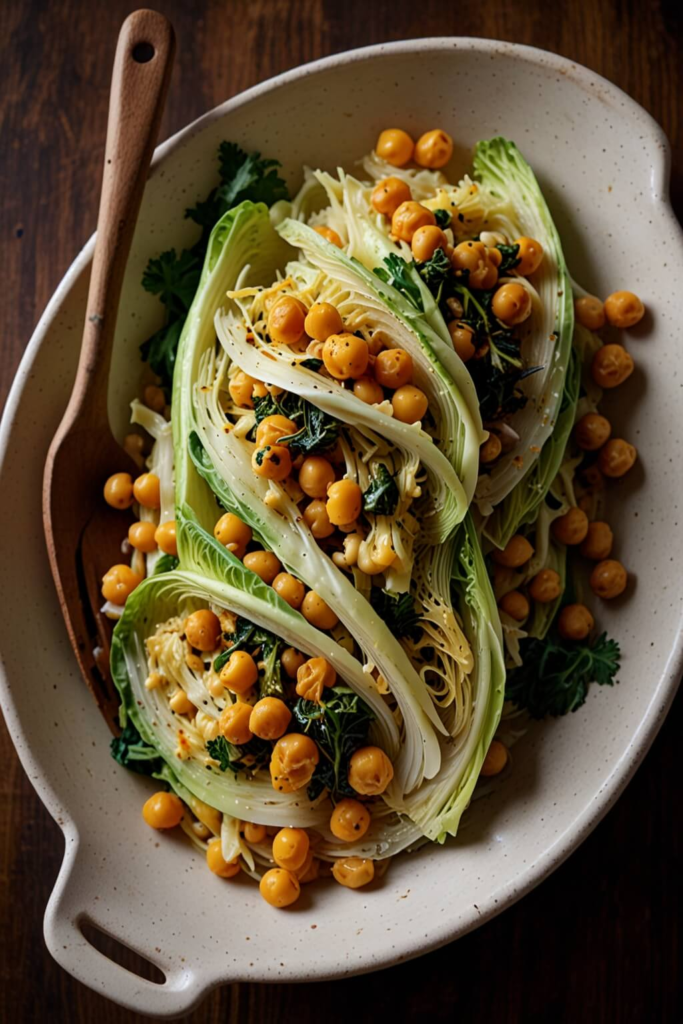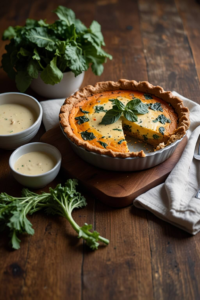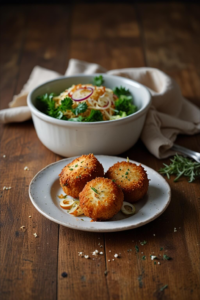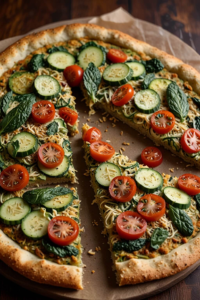Part One: Preparing the Ingredients
Selecting the Perfect Cabbage
Types of Cabbage Suitable for Roasting
To start your journey towards a delicious roasted cabbage dish, choosing the right type of cabbage is crucial. Green cabbage, with its sturdy leaves and mildly sweet flavor, is perfect for roasting. Another great option is Savoy cabbage, which offers a more crinkled texture and a slightly earthier taste. Both types hold up well under heat and develop a wonderful caramelization that enhances their natural sweetness.
How to Choose Fresh Cabbage
When picking fresh cabbage for roasting, look for heads that are dense and heavy for their size. The leaves should be crisp and tightly packed, with no major blemishes or wilted outer layers. Freshness is key, as a fresher cabbage will provide better texture and flavor once roasted.
Gathering Your Chickpeas and Spices
Choosing Between Canned or Dried Chickpeas
Dried chickpeas, once soaked and cooked, tend to have a superior texture and taste, making them ideal for a creamy sauce. However, if time is a constraint, canned chickpeas are a convenient alternative. Just ensure they are thoroughly rinsed and drained to remove any excess sodium and preservatives.
Essential Spices for the Turmeric Sauce
The turmeric sauce is what sets this dish apart, bringing its vibrant color and rich flavors. Essential spices include turmeric, of course, for its earthy and peppery flavor, as well as cumin, coriander, and a touch of cayenne for some heat. Together, these spices create a harmonious blend that complements the chickpeas wonderfully.
Additional Ingredients
Oils and Acids for Enhanced Flavor
To bring out the robust flavors of the cabbage and chickpeas, incorporating quality fats and acids is crucial. A good olive oil or avocado oil will not only help in roasting the cabbage to perfection but also in blending the sauce smoothly. For acids, a splash of lemon juice or apple cider vinegar can brighten the dish, adding a necessary zing that balances the earthy spices.
Garnishing for Presentation
Finally, the garnishing not only enhances the visual appeal but also introduces additional layers of flavor and texture. Consider sprinkling some toasted sesame seeds, freshly chopped cilantro, or even some crushed nuts for that extra crunch. Each garnish should complement the dish and elevate the overall eating experience.
These preparatory steps are essential for building a foundation of flavor and texture that will carry through the cooking process. As you move on to roasting the cabbage and preparing the chickpea sauce, keep these tips in mind for a delightful culinary creation.
Part Two: Roasting the Cabbage
To achieve that perfect golden-brown crust on your cabbage, roasting is key. This section focuses on how to prepare, season, and roast your cabbage flawlessly.
Preparing the Cabbage for Roasting
Cutting Techniques
When preparing cabbage for roasting, the way you cut it is crucial for promoting even cooking and maximizing flavor absorption. First, remove any loose or damaged outer leaves. Next, slice the cabbage into wedges, keeping a bit of the core attached to each wedge to hold the leaves together during roasting. Ideally, each piece should be about 1 to 2 inches thick, ensuring that they cook through without burning on the edges.
Seasoning Before Roasting
Before roasting, seasoning the cabbage correctly enhances its natural flavors. Drizzle a generous amount of olive oil over the cabbage wedges, then sprinkle with salt, pepper, and any other desired seasonings, such as garlic powder or paprika. Rub the seasoning evenly over the wedges to coat them thoroughly, which helps to achieve a delicious caramelization in the oven.
Oven Settings and Roasting
Optimal Roasting Temperatures
The ideal temperature for roasting cabbage in the oven is 400°F (204°C). This high heat helps to caramelize the sugars in the cabbage, resulting in a sweet and savory char that’s incredibly appealing.
Timing and Rotation for Even Cooking
Place the seasoned cabbage wedges on a baking sheet lined with parchment paper to prevent sticking. Roast in the preheated oven for about 25 to 30 minutes. Halfway through, turn the wedges over to ensure they brown evenly on both sides. Keep a close eye on them towards the end of cooking to prevent over-roasting, which could lead to bitter flavors.
Post-Roasting Tips
Resting the Cabbage
Allow the roasted cabbage to rest on the baking sheet for a few minutes after removing it from the oven. This resting period helps redistribute the juices within the cabbage, enhancing its natural flavors and making it more enjoyable to eat.
Adjusting Textures and Flavors
After resting, you might find the need to adjust the texture and flavor slightly. If the edges aren’t as crispy as desired, pop the cabbage back in the oven for an additional 5-10 minutes. Alternatively, if the cabbage is too dry, a drizzle of olive oil or a squeeze of fresh lemon juice can enrich the flavor and add moisture, giving you that perfect balance of texture and taste.
With these steps, your roasted cabbage will not only taste incredible but will also present beautifully alongside the creamy turmeric chickpea sauce, making for a dish that’s as nutritious as it is vibrant.
Part Three: Creamy Turmeric Chickpea Sauce
In this section, we’re diving into the heart of our aromatic dish – the creamy turmeric chickpea sauce. This flavorful condiment will marry beautifully with the roasted cabbage prepared earlier. Remember, the keys to a successful sauce are patience and attention to detail. We will start with preparing the chickpeas, move on to blending them into a sauce, and finish with perfecting the seasoning.
Preparing the Chickpeas
Pre-soaking Dried Chickpeas
Starting with dried chickpeas provides control over texture and flavor, which is crucial for our sauce. First, remember to soak your chickpeas overnight in plenty of water; this step cuts down the cooking time and improves digestibility. Moreover, the soaking process activates certain nutrients making them more beneficial.
Cooking Chickpeas to the Ideal Texture
After soaking, drain and rinse the chickpeas, then place them in a large pot covered with fresh water. Cook them on a gentle simmer. Be patient here; depending on their age and size, this could take anywhere from 45 to 90 minutes. You’ll know they’re done when they are tender and easily crushed between two fingers, but still hold their shape.
Creating the Sauce Base
Blending the Chickpeas with Spices
Once your chickpeas are cooked, reserve some of the cooking liquid, and blend the chickpeas. Add turmeric, garlic, cumin, and a splash of lemon for vibrant flavor. Blend these together until smooth. If the mixture is too thick, add a bit of the reserved cooking liquid to reach a creamy consistency.
Optimal Consistency and Thickness
Achieving the perfect creamy texture requires patience and incremental adjustments. Start with less liquid and add more as needed. The goal is a thick sauce that still flows gently off a spoon, similar to a classic béchamel.
Seasoning and Final Touches
Adjusting Spices
Taste your sauce after blending. This is crucial as the flavors will change after they mingle. Add salt, more lemon juice, or a dash of cayenne pepper depending on your taste. Sometimes, a touch more turmeric can bring out a more vibrant color and earthiness.
Serving Suggestions
This sauce is versatile. Pour it warm over the roasted cabbage or use it as a dip for fresh vegetables. It also pairs wonderfully with grilled meats or as a base for a vegetable gratin. If not used immediately, keep it refrigerated and reheat gently, adding a little water if it thickens too much upon cooling.
By following these detailed steps, you’ll ensure that your turmeric chickpea sauce is not only delectable and rich but also visually appealing and fragrant, making it a highlight of any meal.
Print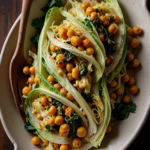
Roasted Cabbage Wedges with Creamy Turmeric Chickpea Sauce
- Temps total: 45 minutes
- Rendement: 4 servings 1x
Description
Roasted Cabbage Wedges with Creamy Turmeric Chickpea Sauce combines hearty textures with rich, spiced Indian cuisine inspired flavors. This nutritious meal is perfect for health-conscious eaters.
Ingrédients
- 1 large head of green cabbage, cut into 8 wedges
- 3 tablespoons olive oil
- Salt and black pepper to taste
- 1 can (15 ounces) chickpeas, drained and rinsed
- 1 cup coconut milk
- 2 teaspoons ground turmeric
- 1 teaspoon ground cumin
- 1/2 teaspoon chili powder
- 2 cloves garlic, minced
- 1 tablespoon lemon juice
- Fresh cilantro or parsley for garnish
Préparation
- Preheat oven to 400 degrees Fahrenheit. Slice cabbage into 8 wedges keeping the core intact. Drizzle olive oil, season with salt and pepper, and place on a baking sheet.
- Roast in the oven for 25-30 minutes, turning halfway.
- Blend chickpeas, coconut milk, turmeric, cumin, chili powder, garlic, and lemon juice until smooth for the sauce.
- Serve cabbage with cream sauce and garnish with fresh herbs.
Remarques
- Add grated ginger to the sauce for extra flavor.
- Use red cabbage for a colorful variation.
- Enhance spiciness with a dash of cayenne pepper.
- Préparation: 15 minutes
- Cuisson: 30 minutes
- Catégorie: Dinner
- Méthode: Roasting
- Cuisine: Indian-inspired
Nutrition
- Serving Size: 1 wedge
- Calories: 250
- Sugar: 5g
- Sodium: 300mg
- Fat: 15g
- Saturated Fat: 7g
- Unsaturated Fat: 8g
- Trans Fat: 0g
- Carbohydrates: 25g
- Fiber: 6g
- Protein: 7g
- Cholesterol: 0mg
Mots clés: Roasted Cabbage, Creamy Turmeric Chickpea Sauce, Healthy Dinner

